#gram masala
Explore tagged Tumblr posts
Text










Nurse need their shots too 🤣
#self love#stress relief#livelife#live happy#happyday#photography#cheadle#gram masala#indian cuisine#happy hour#friends
2 notes
·
View notes
Text

Fruity chicken makhani.
I was drooling 🤤🤤whilst I was making it, man, it tasted better than I envisaged 😋😋😋
#fruity chicken makhani#my recipe#better than a bought one#tomatoes#yoghurt#gram masala#ginger#cayane pepper#garlic#butter ghee#raisins#sultanas#banana#cranberries#apricots#onion
0 notes
Text
Anyway, here were the dishes we ordered. The first to be served was the Rigatoni Alla Vodka (S$22++), penne in tomato and cream sauce with vodka added. The vodka emulsifies the sauce and enhances flavour. I got to try a piece of the pasta and alcohol was quite pronounced.

Two people ordered the Stone Age Burger (S$20++) with angus beef patty, cheese, red onion, pickles and coated straight-cut fries. Although I did not get to try the burger, I was given some fries and it was well flavoured and crispy on the outside and fluffy inside.

Both my two colleagues next to me had the Stone-Cut Schnitzel (S$28++) which is deep-fried tenderized pork loin cutlet with sour potato salad, cranberry compote and lemon. They finished every bit on the plate, so must be good.

Colleague’s family had this Cave Smoked Rib (S$36++) to share. 500 grams of pork rib barbecued to perfection and glazed with BBQ sauce. Came with a side of pickled cucumbers. She told me it was very good so you will have to take her words for it. :D.

My Charcoal-Grilled Spring Chicken (S$28++) was the last to be served, but it was worth the wait. A juicy and succulent whole spring chicken grilled to a mouthwatering goodness, covered in lightly spicy peri-peri sauce. Gave the lemon a squeeze to release the juice which helps to cut down the greasiness and add acidity.


Since we still have more than a hour to waste before the bus will arrive to ferry us back, colleagues suggested we go have a drink. We had exited the park and wander around the vicinity looking for a place to hang out. One colleague said she wanted to drink Masala Tea so we went to an Indian Restaurant. Other than the two of us who ordered Masala Tea, the others did not enjoy their tea which is either too sweet or tasteless or both. No tea pictures to show but we found many Torch Ginger Flowers (Etlingera elatior) blooming along the way and Waterfall.




To summarise the visit to Rainforest Wild Asia. If you are here to see the animals, you might end up a little disappointed as there aren’t a lot to be seen. Here, the landscapes imitate the rainforest of Asia with plenty of flora and most of the animals are not used to be up close with humans, so they tend to stay away from the open area. Overheard another group of visitors’ conversation, she was lamenting to another about having only seen tortoises. :D Poor girl needs to open her eyes big big to spot the animals among the trees, shrubs and brushes. On the other hand, if you are the adventurous type, there are plenty of hands-on activities to enjoy though not all of them are free. You can also venture off the beaten path (elevated walkway) and explore the streams and undergrowth of a tropical rainforest.
#Rainforest Wild Asia#Mandai Wildlife Reserve#Newly Open#Zoological Park#Cavern Restaurant#Rigatoni Alla Vodka#Pasta#Stone Age Burger#Cave Smoked Rib#Charcoal-Grilled Spring Chicken#Torch Ginger Flower#Etlingera elatior#Company's Outing#Waterfall#Flora#Lunch#Food#Buffetlicious
126 notes
·
View notes
Text
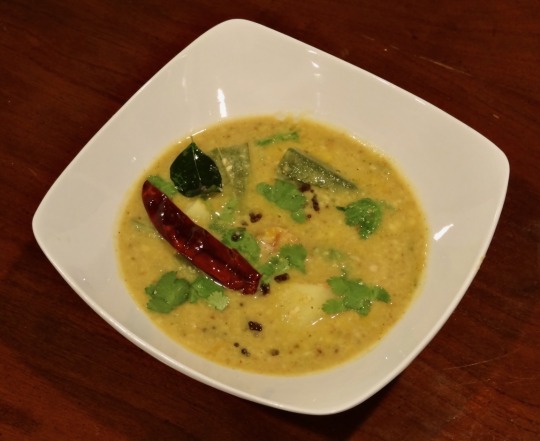
[ID: A bowl of a bright yellow stew topped with cilantro, mustard seed, chili, and curry leaf. End ID]
ಉಡುಪಿ ಸಾಂಬಾರ್ / Udupi sambar
A sambar is a lentil-and-vegetable stew distinguished by the use of a particular spice blend (Hindi: सांबर मसाला "sāmbār masālā," "sambar spice"; Kannada: ಸಾಂಬಾರ್ ಪುಡಿ "sāmbār puḍi," "sambar powder"). Sambars are a staple of South Indian and Sri Lankan cooking, sometimes made in households for multiple meals a week. The word "sambar" can be traced back to the Sanskrit सम्भार "sambhārá," "collection of things required for a particular purpose”; “spices."
The lentil used in sambar dishes is usually tur dal (split pigeon peas), though arhar dal, tuvur dal, or even blends containing masur or mung dal may be used, depending on the cook or the region. Vegetables also vary between combinations of okra, potato, ash gourd (petha), bottle gourd (doodhi / lauki), drumstick (saijan ki phalli), beetroot, tomato, carrot, pumpkin, brinjal, and pearl onions, among others. The sambar masala fries chilis, curry leaves, dal, and various spices including cumin, coriander, and fenugreek, then grinds them into a spicy, earthy, fragrant blend.
This recipe makes a sambar in the style of ಉಡುಪಿ (Udupi) cuisine—a subdivision of the cuisine of the ತುಳುವ (Tuluva) people localised in the Udupi District of Karnataka, a southeastern coastal state of India. (Tuluva cuisine is also commonly found in Dakshina Kannada, Karnataka, and Kasaragod, Kerala). In the Udupi region, sambar may be known as "ಕೊಡೆಲ್" "kodhel"; perhaps related to "ಕಡಲೆ" "kadhale" "Bengal gram"; or "ಹುಲಿ" "huḷi"; "tartness." Udupi huli has coconut oil and jaggery as its primary distinguishing features: the jaggery's deep sweetness and the earthy pungency of unrefined coconut oil combine with the spice of the chilis and the sour fruitiness of the tamarind to create a complex, flavorful, well-balanced dish.
Udupi huli may be further divided into a few major types. ಮಸಾಲೆ ಹುಳಿ ("masāla huḷi") contains shredded coconut and vegetables; ಬೋಳು ಹುಳಿ ("bolu huḷi") contains vegetables, but omits the coconut.
Hotel-style masala huli recipes typically add a lot of jaggery to produce a distinct sweetness; cut back on the amount of coconut included; and contain onion and garlic. The other main type of masala huli—“temple style”—is sattvic (from Sanskrit "सत्त्व" "sattva": "goodness," "essence," "existence"), which in this context means that onions and garlic are excluded.
A sattvic diet in Hinduism centres around the concept of maintaining sattva by eating only pure and mild (sattvic) foods, and omitting tamasic (“dark,” "inert," "destructive"; from Sanskrit तमस् "tamas") and rajasic ("exciting," "passionate," from Sanskrit रजस् "rajas") ones. The concepts of sattva, tamas, and rajas (the गुण "guṇa" system) are central to the construction of caste: the degree to which each person innately inherits each quality supposedly determines their possession of characteristics including honesty, intelligence, and goodness (sattva), stupidity and lack of creativity (tamas), and passion and pridefulness (rajas); the possession of these characteristics in turn determines their rightful place in a professional and social hierarchy. The association of certain foods with certain qualities thus links diet to caste: a distinction in diet is one of the methods by which those belonging to upper castes maintain and police caste boundaries.
This recipe makes enough pudi for one pot of sambar. Traditionally, sambar pudi is created fresh each time the dish is made, but many households make large batches and store them. In this case, omit the coconut; or, use dried coconut and store the masala in the refrigerator.
Recipe under the cut!
Patreon | Paypal | Venmo
Ingredients:
Serves 4-6.
For the sambar:
2 cups chopped vegetables
1 red onion, sliced*
1 cup (200g) yellow split pigeon peas / tur dal / ತೂರ್ ದಾಲ್ (ಹಳದಿ ಸ್ಪ್ಲಿಟ್ ಪಾರಿವಾಳದ ಬಟಾಣಿ)
4 cups (1 litre) water, or as needed
1/4 tsp ground turmeric / haldi / ಅರಿಶಿನ
2 tsp table salt
2 tsp jaggery / gur / ಬೆಲ್ಲ*
1/4 cup (60mL) tamarind pulp (from 1 Tbsp dried tamarind / imlie / ಹುಣಸೆಹಣ್ಣು)
2 tsp unrefined coconut oil / nariyal ka tel / ತೆಂಗಿನ ಎಣ್ಣೆ
Ingredient list format is English / Hindi (Latin transcription) / Kannada. The Hindi is provided for convenience while shopping.
Udupi sambar usually uses any of: gourd, brinjal (Indian eggplant), pumpkin, dumstick (saijan ki phalli), and okra. Pearl onion is not usually used in this region, but you can add whatever you want, according to taste.
*For a hotel-style sambar, include the onion; increase the jaggery to 2 Tbsp.
For the spice paste / sambar masala / ಸಾಂಬಾರ್ ಪುಡಿ ("sambar pudi"):
1/2 Tbsp split Bengal gram / chana dal / ಹಳದಿ ಸ್ಪ್ಲಿಟ್ ಗ್ರಾಂ
2 tsp split black gram / urad dal chilka / ಸ್ಪ್ಲಿಟ್ ಬ್ಲ್ಯಾಕ್ ಗ್ರಾಂ
2 tsp coriander seeds / dhaniya / ಕೊತ್ತಂಬರಿ ಬೀಜದ
1/2 tsp fenugreek seeds / methi / ಮೆಂತ್ಯ
1 tsp cumin seeds / jeera / ಜೀರಿಗೆ
1 tsp ground turmeric
5-6 curry leaves / kari pati / ಕರಿಬೇವು
3-4 Byadagi or other dried red chilis / byadagi mirch / ಬ್ಯಾಡಗಿ ಮೆಣಸಿನಕಾಯಿ
4 cloves garlic, skins on*
Large pinch asafoetida / hing / ಇಂಗು
1 cup (100g) fresh coconut (about one coconut)*
1/2 cup (120mL) water
While the ratio of ingredients in Udupi sambar pudi vary slightly, the ingredients themselves are almost always consistent.
*For a hotel-style sambar, include the garlic, and decrease the coconut in the sambar masala to 1/4 or 1/2 cup (25-50g).
The grams and pulses in this pudi have many different names. You can find them in a halal or South Asian grocery store; look on the bag for the Hindi names (since they have been transcribed into Latin, the spelling may vary from what you see here).
The urad dal you find may be husked, and thus yellow instead of black; these will work just as well.
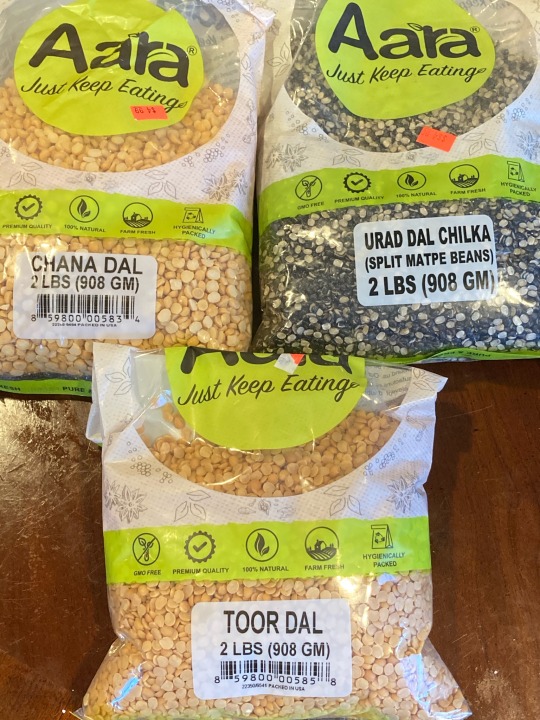
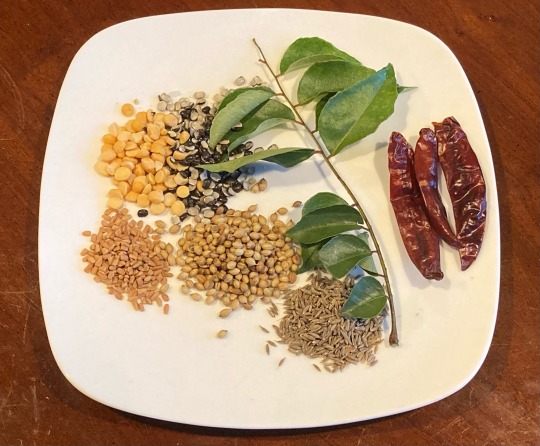
For the tempering / tadka / ಹದಗೊಳಿಸುವ:
2 Tbsp unrefined coconut oil
2 red chilis
8 curry leaves
1 tsp brown mustard seeds / rai / ಸಾಸಿವೆ ಬೀಜಗಳು
Recipes from north Karnataka may add cumin and whole, unpeeled garlic cloves to the tempering.
Instructions:
For the sambar pudi:
1. Break open the coconut and remove and shread its flesh.
If using a whole dried coconut, break into the shell with the wrong side of a hammer and pry open. Break into a few smaller pieces and peel with a vegetable peeler until the skin is removed from the white flesh, wearing something to protect your hand. Soak in warm water for several minutes to soften, and then grate or food process.
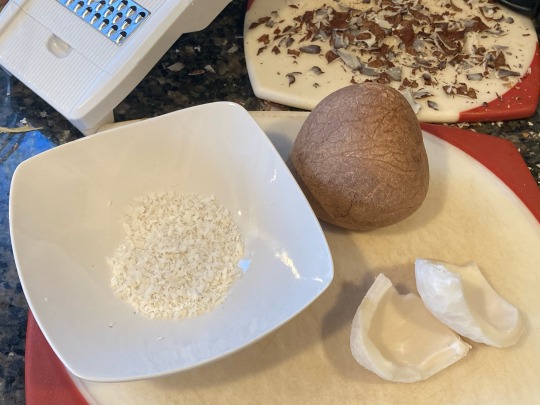
2. Heat 2 Tbsp of coconut oil in a skillet on medium-low. Add asafoetida and fry for 30 seconds, until no longer raw-smelling. Add dal and fry, stirring often, for 30 seconds until golden brown; add coriander, mustard, fenugreek, and cumin seeds and fry until fragrant.
3. Add curry leaves and fry until wilted, then add garlic and dried chilis and fry another 30 seconds to a minute, until fragrant.
4. Add coconut and fry, stirring often, for another few minutes until a shade darker. Add turmeric and stir.
5. Grind all ingredients into a paste in a mortar and pestle, then mix in about 1/2 cup water to loosen (if using dried coconut, you may need more water).
Or, put all ingredients along with 1/2 cup water into a blender or food processor and process until a relatively smooth paste forms.
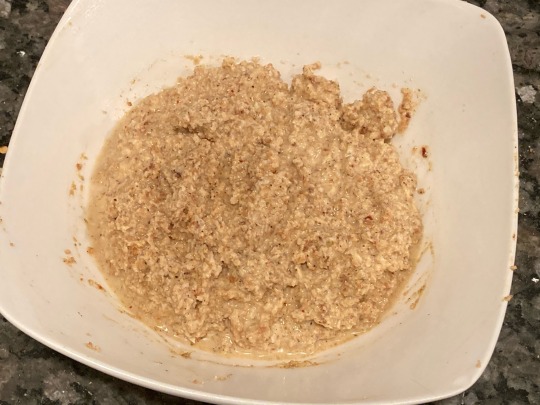
For the sambar:
1. Wash tur dal to remove excess starch. Simmer dal with 2 cups water, 1/4 tsp ground turmeric, and 1 tsp coconut oil for about 30 minutes until very tender. Mash until relatively smooth with a wooden spoon or bean masher, or process briefly with an immersion blender.
You may soak the dal in water after rinsing them to reduce the cooking time, but it is not necessary.
2. Meanwhile, make the tamarind paste. Soak 1 Tbsp tamarind dried pulp in 1/4 cup hot water for 20-30 minutes. Squeeze the tamarind into the water to extract the pulp. Discard the tamarind seeds and husk. Optionally, depending on your preferred texture, push the mixture through a metal sieve.
3. Prepare vegetables. Slice the onion; remove ends of okra and drumsticks and cut into 2-inch pieces; quarter tomatoes; quarter brinjal; peel pumpkin and cut into cubes; peel and cube potatoes.
4. If using onion, add a teaspoon of coconut oil to a large pot and fry until translucent.
5. In the same pot, boil vegetables in just enough water to cover, along with a pinch of salt, until they are beginning to soften.
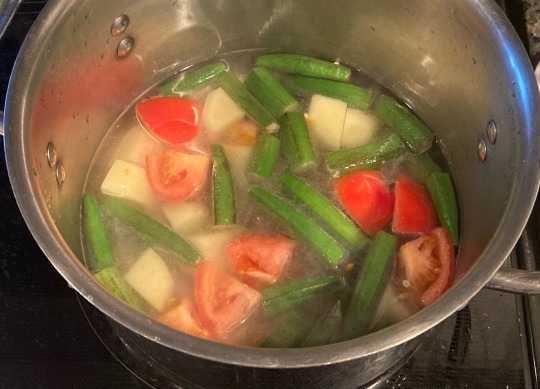
Some recipes call for the vegetables to be boiled, and others call for them to be steamed. I prefer boiling, since it produces a nice savory broth.
6. Mix vegetables, dal, tamarind, jaggery, sambar pudi, and salt to taste and simmer 5-10 minutes to allow flavors to combine and vegetables to cook under tender. Add water as needed. Remove from heat and stir in cilantro. Taste and adjust salt.
The final sambar should be pourable, like a thick soup—Karnataka sambar is typically thinner in consistency than Tamil Nadu versions.
For the tadka:
1. Heat coconut oil in a small skillet on medium heat. Add tempering ingredients and fry, stirring often, until chilis and curry leaves are a couple shades darker and the mixture is fragrant.
2. Pour the oil and tempering ingredients into the sambar and stir in. If you like, retain some of the tadka as a garnish to serve.
3. Serve warm, in individual bowls, alongside long-grain white rice. To eat drumsticks, scoop the center out and eat it; the tough outer rind is left.
If you intend to save some sambar, it's a good idea to make just enough tadka for what you plan to eat that day, and then make fresh tadka to pour over the reheated leftovers.
129 notes
·
View notes
Text

Indian Lentil Curry with Spinach (Dal Makhani)
Ingredients:
- 1 cup black urad dal (whole black gram lentils)
- 1/4 cup rajma (kidney beans)
- 1 large onion, finely chopped
- 2 cloves garlic, minced
- 1-inch piece ginger, grated
- 1 teaspoon cumin seeds
- 1/2 teaspoon coriander seeds
- 1/4 teaspoon turmeric powder
- 1/2 teaspoon red chili powder (adjust to taste)
- 1/2 teaspoon garam masala
- 1 can (14.5 oz) diced tomatoes
- 1 cup chopped fresh spinach
- 1 tablespoon ghee (clarified butter)
- Salt to taste
- Chopped cilantro for garnish
Instructions:
1. Rinse the urad dal and rajma thoroughly. Soak them in water for at least 8 hours, or overnight. Drain and set aside.
2. Heat ghee in a large pot over medium heat. Add cumin and coriander seeds and let them sizzle for a few seconds. Add onions, garlic, and ginger and sauté until softened and fragrant.
3. Stir in turmeric, red chili powder, and garam masala. Cook for 30 seconds, or until fragrant.
4. Add the soaked lentils, diced tomatoes, and salt to the pot. Stir well to combine. Pour in enough water to cover the lentils by 2 inches. Bring to a boil, then reduce heat to low and simmer for 30-45 minutes, or until the lentils are tender and the curry has thickened.
5. Stir in the chopped spinach and cook for a few minutes, or until the spinach wilts.
6. Adjust the seasoning with salt to taste. Garnish with chopped cilantro and serve hot with rice or naan bread.
This hearty and flavorful Indian lentil curry is not only delicious but also packed with nutritional benefits. Lentils and kidney beans provide plant-based protein, while the fiber in lentils and spinach aids digestion and promotes a feeling of fullness. Additionally, the curry is rich in vitamins such as B vitamins, iron, and potassium. The spices and vegetables in the curry also provide antioxidants that help protect cells from damage.
#comfort food#food for thought#fast food#healthy food#food photography#food fight#foodie#food#foodpics#foodmyheart#tw food#foodlover#lunch recipes#pasta recipes#pasta recipe#salad recipes#soup recipe#recipe#reciprocidade#reciprocity#recipies#recipes#cozy autumn#cozy art#cozyhome#cozy cozy#cozy mystery#healhtylifestyle#healthy salad recipes#healthy lunch ideas
18 notes
·
View notes
Text
Bachelor's Biryani
I'm glad to say this because biryani is our Indian culture and traditional food follows from those periods. This is our proud moment because we spread our cuisine to the world over . which means everybody likes biryani to enjoy it with their family. so we will discuss how to make bachelor chicken biryani or biryani recipe.
Shall we start slogan of biryani:
“Biryani is not just food; it's an emotion.”
This biryani is especially made for bachelor. Even family people also do this at your home. MUST TRY ONE DON'T MISS IT.
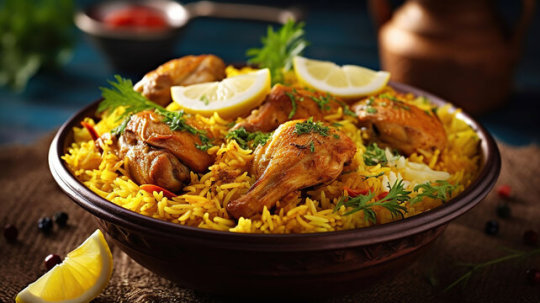
QUANTITY :- 4 TO 5 PERSON
COOKING TIME :- 25 TO 30 MINS
PREPARATION:- 10MINS
INGREDIENTS & QUANTITY :-
Basmati Rice - 500 grams
Chicken - 500 grams
Oil - 150ml
Onion - ( 2 Medium size )
Tomato - ( 4 Medium size )
Lemon - 1/2 (Not shown in video)
Cinnamon - 2
Cardamom - 2
Bay leaf -2 To 3 (OR) As required
Clove - 2
Mint Leaves - As required
Ginger & Garlic paste -50 grams
Red Chilli powder - 2 tsp
Gram masala - 2tsp
Aachi Kolambu masala-3tsp
Curd - 100ml
Green Chilli - 4(medium size)
Water - 1000ml
COOKING PROCESS:-
STEP-1 :
TAKE ALL THE INGREDIENTS BEFORE START YOUR COOKING
STEP-2:
TAKE THE COOKER AND PLACE IT ON THE STOVE FOR 2 MINS AFTER IT GETS HEATED ADD THE REFINED OIL (150 TO 200ML) AS YOUR REQUIRED .
OIL GETS HEATED ADD THE MASALA LIKE(CINNAMON, CARDOMAN, ELACHI, BAYLEAF ,FENNEL ETC..)

STEP-3:
SAUTE IT WELL FOR A FEW MINUTES. ADD THE CHILLI (5 NO) IN MEDIUM SIZE AND SAUTE IT WELL HERE ADD SOME AMOUNT OF ONION (2 OR 3 ONIONS)AND SAUTE IT WELL UNTIL THE ONION COLOR TURNS NAVY PINK. AFTER THIS ADD THE GINGER & GARLIC PASTE(50 TO 60 ML).


STEP-4:
SAUTE IT WELL UNTIL THE RAW SMELL WENT OUT. IN THIS STAGE ADD A FEW AMOUNTS OF MINT LEAF AND 3 OR 4 TOMATOES (FRUITY STAGE) BECAUSE THEY GIVE A TASTE AND FLAVOR AS GOOD AS BIRYANI. SAUTE IT WELL WITH THE GRAVY FOR A FEW MINUTES UNTIL TOMATOES GET MIXED WITH THE GRAVY HERE IS THE STAGE IS GOOD TO ADD THE CURD(100 TO 200 ML ) SAUTE IT WELL WITH GRAVY.




STEP-5:
HERE ADD THE 500 GRAMS OF CHICKEN AND MIX IT WELL FOR 5 MINUTES AND THE MASALA SUCH AS
RED CHILLI POWDER :- 2 TO 3 TSP
GRAM MASALA POWDER :- 2 TSP
AACHI KOLAMBU MASALA :- 4 TSP
SALT :- AS REQUIRED
LEMON :- 3TSP
NOTE:- CHECK THE MASALA RATIO IS CORRECT FOR YOUR COOKING PROCESS



STEP-6:
SAUTE IT WELL WITH THE ADDED MASALA FINALLY ADD WATER (200ML) AND LEAVE FOR A FEW MINUTES NOW IT IS THE CORRECT TIME TO MEASURE THE RATIO OF MASALA CORRECTION. IF IT IS CORRECT MEANS FINALLY ADD THE (450 TO 500 GRAMS OF RICE) HERE ADD THE WATER REMAINING 800 ML OF WATER DOUBLE THE RATIO OF THE RICE QUANTITY


STEP-7:
FINALLY, CLOSE THE COOKER (LOCK THE GAS CUT )AND LEAVE 30 TO 40 MINUTES LOW FLAME. AFTER 45 MINUTES .


*******************IT WILL READY TO SERVE***********************

READ MORE
youtube
WATCH OUR VIDEO
சமையல் செயல்முறை:
உங்கள் சமையலைத் தொடங்கும் முன் அனைத்துப் பொருட்களையும் எடுத்துக் கொள்ளுங்கள்.
குக்கரை எடுத்து 2 நிமிடங்களுக்கு அடுப்பில் வைக்கவும், அது சூடாக்கப்பட்ட பிறகு, உங்களுக்குத் தேவையான சுத்திகரிக்கப்பட்ட எண்ணெயைச் (150 முதல் 200 மில்லி வரை) சேர்க்கவும்.எண்ணெய் சூடாக்கப்பட்ட பிறகு மசாலாவைச் சேர்க்கவும் (இலவங்கப்பட்ட, எலச்சி, பேய்லீஃப், பெருஞ்சீரகம் போன்றவை..).
சில நிமிடங்களுக்கு நன்றாக வதக்கவும். மிளகாயை (5 எண்கள்) நடுத்தர அளவில் சேர்த்து நன்றாக வதக்கவும். இங்கு சிறிது வெங்காயம் (2 அல்லது 3 வெங்காயம்) சேர்த்து, வெங்காய நிறம் நேவி டின்க் மாறும் வரை நன்றாக வதக்கவும். இதற்குப் பிறகு இஞ்சி மற்றும் பூண்டு விழுது (50 முதல் 60 மில்லி) சேர்க்கவும்.
பச்சை வாசனை போகும் வரை நன்றாக வதக்கவும். இந்த கட்டத்தில், சில அளவு புதினா இலை மற்றும் 3 அல்லது 4 தக்காளி (பழ நிலை) சேர்க்கவும், ஏனெனில் அவை பிரியாணியைப் போலவே சுவையையும் சுவையையும் தருகின்றன. தக்காளி கிரேவியுடன் கலக்கும் வரை சில நிமிடங்களுக்கு கிரேவியுடன் நன்றாக வதக்கவும், இதோ தயிரை (100 முதல் 200 மிலி வரை) சேர்ப்பது நல்லது.
இங்கே 500 கிராம் கோழியைச் சேர்த்து 5 நிமிடம் மற்றும் மசாலா போன்றவற்றை நன்கு கலக்கவும்.
சிவப்பு மிளகாய் தூள்: - 2 முதல் 3 டீஸ்பூன்
கிராம் மசாலா தூள் :- 2 டீஸ்பூன்
ஆச்சி கொலம்பு மசாலா :- 4 டி.எஸ்.பி
உப்பு :- தேவையான அளவு
எலுமிச்சை :- 3டி.எஸ்.பி
மசாலாவுடன் சேர்த்து நன்றாக வதக்கி இறுதியாக தண்ணீர் (200ML) சேர்த்து சில நிமிடங்கள் விடவும், இப்போது மசாலா திருத்த விகிதத்���ை அளவிட இதுவே சரியான நேரம். இது சரியாக இருந்தால், இறுதியாக (450 முதல் 500 கிராம் அரிசி) சேர்க்கவும், மீதமுள்ள தண்ணீரை 800 மில்லி தண்ணீரை சேர்க்கவும்.
குறிப்பு:- உங்கள் சமையல் செயல்முறைக்கு மசாலா விகிதம் சரியானதா என சரிபார்க்கவும்
இறுதியாக, குக்கரை மூடி (LOCK GAS CUT) மற்றும் 30 முதல் 40 நிமிடங்கள் குறைந்த தீயில் விடவும். 45 நிமிடங்களுக்குப் பிறகு.
***********இது சேவை செய்ய தயாராக இருக்கும்***********
DESCRIPTION:-
Simple Chicken Biryani with Biryani masala| கோழி பிரியாணி | Cooker Dum Biryani | Spice Eats Chicken Biryani | Chicken Biryani Recipe | Simple Chicken Biryani for Beginners | Chicken Biryani Recipe for Bachelors. சிக்கன் பிரியாணி குக்கரில் குழையாமல் 😋 எப்படி செய்வது | CHICKEN BIRIYANI RECIPE IN PRESSURE COOKER
#chicken #chickenbiryani #bachelorchickenbiryani #briyani #dumbiryani #recipe
Thank you for visiting my blog
The blog was written by JEGANATHAN A (SAMATHANAM KITCHEN)
7 notes
·
View notes
Text
Herby Lamb Curry with Aubergine and Potatoes

This fragrant Herby Lamb Curry with Aubergine and Potatoes is both hearty and light enough, making it a deliciously more-ish dinner to tuck into on these chillier Summer nights! Happy Wednesday!
Ingredients (serves 2):
4 medium Garden Potatoes
1 teaspoon coarse sea salt
4 tablespoons olive oil
1 teaspoon Graines à Roussir
2 thick slices (about 420 grams/ounces total) lamb leg
1 large aubergine, rinsed
1 large carrots
1 onion
1/3 hot chilli pepper
1 large garlic clove, minced
a bunch Garden Cilantro
half a dozen large leaves fresh mint
2 teaspoons ground turmeric
1 teaspoon Garam Masala
1/2 teaspoon fleur de sel or sea salt flakes
1/2 teaspoon freshly cracked black pepper
1 tablespoon demerara sugar
a few sprigs Garden Cilantro
a few mint leaves
Rinse and peel Garden Potatoes and place them in a large saucepan. Add coarse sea salt and cover with water. Bring to the boil over medium-high heat, and cook, about 15 minutes.
Meanwhile, heat half of the olive oil in a large, deep skillet or pot over medium-high heat. Add Graines à Roussir; fry, 1 minute. Add lamb leg pieces, and brown thoroughly, about 3 to 4 minutes on each side. When well-browned, transfer lamb pieces to a plate, set aside.
Cube aubergine, and stir into the skillet, coating in lamb fat and olive oil. Cover with a lid, and cook, a couple of minutes.
Peel and slice carrot. Finely chop onion.
When aubergine has just softened and browned a bit, add remaining olive oil, and stir in sliced carrot and chopped onion. Cook, another couple of minutes.
Thinly slice chilli pepper, and stir into the skillet, along with minced garlic. Cook, 1 minute.
Finely chop Garden Cilantro and mint leaves, and stir into the skillet. Cook, a couple of minutes more.
Then, season with ground turmeric and Garam Masala.
Drain Potatoes, saving their cooking water, and stir them into the skillet, coating in herbs and spices.
Return lamb chunks to the skillet, seasoning them on both sides with fleur de sel and black pepper.
Finally, stir in 1 1/2 to 2 cups of the Potatoes cooking water, and bring to the boil. Reduce heat to medium-low, and simmer, at least an hour.
Just before serving, stir demerara sugar into the skillet, until completely dissolved.
Finely chop Garden Cilantro and mint leaves.
Serve Herby Lamb Curry with Aubergine and Potatoes hot, sprinkled with chopped Cilantro and mint.
#Recipe#Food#Herby Lamb Curry with Aubergine and Potatoes#Herby Lamb Curry with Aubergine and Potato recipe#Herby Lamb Curry#Lamb Curry#Lamb Curry recipe#Lamb#Lamb Leg#Lamb Veal and Game#Olive Oil#Aubergine#Carrot#Onion#Chilli#Chilli Pepper#Chili Pepper#Garlic#Turmeric#Ground Turmeric#Garam Masala#Potatoes#Garden Potatoes#Cilantro#Fresh Cilantro#Mint#Fresh Mint#Fleur de Sel#Black Pepper#Black Peppercorns
9 notes
·
View notes
Text
Is It Hard for Vegetarians to Get Enough Protein?
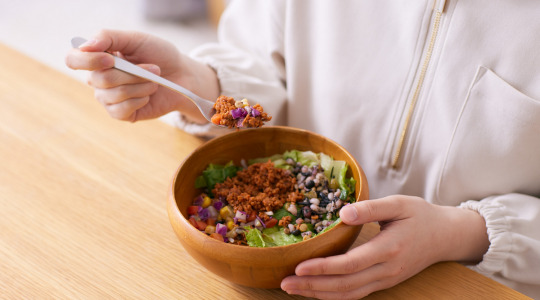
When we think of protein, it is easy to picture plates filled with eggs, chicken, or fish. It often raises a question: without meat or eggs, how do vegetarians meet their protein needs?
Protein plays a central role in the body. It helps build muscle, repair tissues, strengthen the immune system, and keeps us full for longer. While it may seem that vegetarians would fall short, the reality is different. Many everyday foods supply more than enough protein without requiring major changes.
How Much Protein Do We Need?
Most people need about 0.8 grams of protein per kilogram of body weight. For someone who weighs 60 kilograms, that translates to roughly 48 grams of protein a day. It sounds like a challenge, but with the right combination of foods, it is well within reach.
Lentils and pulses are among the best protein sources for vegetarians. Everyday foods like dal, chickpeas, kidney beans, and black beans are rich in protein. A cup of cooked lentils provides about 15 to 18 grams of protein. When paired with rice or rotis, it makes for a balanced and satisfying meal.
Dairy is another important source. Paneer, curd, milk, and cheese offer high-quality protein along with calcium. One hundred grams of paneer contain about 18 grams of protein. A glass of milk or a bowl of curd adds even more, fitting easily into regular meals.
Soy-based foods like tofu, tempeh, and edamame are excellent plant-based options. Tofu is especially versatile, absorbing the flavors of curries, stir-fries, and salads while delivering a good protein boost.
Chickpeas and beans also contribute significantly. Whether it is chana masala, rajma chawal, or hummus on toast, these foods provide about 15 grams of protein per cooked cup. They are filling and rich in nutrients beyond protein.
Nuts and seeds play their part too. Almonds, peanuts, chia seeds, and sunflower seeds are small but powerful. A handful of almonds or a tablespoon of peanut butter can lift the protein content of a meal. Chia and flaxseeds can be added to smoothies, oatmeal, or yogurt without much effort.
Whole grains like oats, quinoa, and brown rice add another layer of support. Quinoa is one of the few plant-based sources of complete protein, offering about 8 grams per cup. A breakfast of oats with milk and seeds can turn into a strong start to the day.
Even green vegetables contribute. While not as protein-dense, peas, broccoli, spinach, and corn add small amounts that, over time, make a difference when combined with other sources.
A Day of Eating for Protein (Vegetarian Style)
Breakfast: Oats with milk, almonds, chia seeds
Mid-morning: Handful of peanuts or roasted chana
Lunch: Dal with brown rice and curd
Evening: Tofu tikka or paneer sandwich
Dinner: Chickpea salad or rajma with roti
Optional Snack: Greek yogurt or a banana and peanut butter smoothie
Eating a vegetarian diet does not mean falling short on protein. With a mix of lentils, dairy, soy products, nuts, seeds, whole grains, and vegetables, it is possible to meet daily protein needs while also gaining the added benefits of fiber, vitamins, and minerals.
The next time someone wonders how a vegetarian manages without meat, the answer is simple. Plates filled with dal, greens, nuts, and curd are doing more work than they appear. Quietly and steadily, they support the body just as well.
#nutriintact#healthylifestyle#healthy diet#healthy food#healthychoices#food#fitness#healthy eating#healthyhabits#dry fruits#health benefits#soulful#farms#protein#healthyeating#healthy#healthy snack#nutrition#blog#trending#tumblr trends#oats#nuts#almonds#walnuts#cashews
1 note
·
View note
Text
Wholesome Sattu — The Secret to Energy & Tradition in Every Spoon!
Did you know? Sattu is known as “the poor man’s protein” — but its benefits are rich and powerful! 💥 Momazone’s Bengal Gram Sattu Flour is a high-protein, gluten-free, and preservative-free superfood trusted for generations. Ideal for kids, parents, farmers, and anyone who values nutritious energy!
✅ 100% Natural ✅ No Preservatives | No Salt | No Sugar ✅ Energy-Boosting & Gluten-Free ✅ Traditional Indian Health Drink ✅ Special Masala Mix Inside

🌞 Great for summer hydration and strength 🛍 Order now: www.momazone.com 📞 WhatsApp: 8356999078 📸 Follow us: @momazoneindia
#SattuFlour#WholesomeSattu#MomazoneIndia#BengalGramFlour#IndianSuperfoods#HealthyFamilySnacks#NoPreservatives#NaturalProtein#SummerEnergyBooster#GlutenFreeLiving#AyurvedicNutrition#KidsFriendlySnacks#HealthyEatingIndia#SattuBenefits#ProteinPacked
1 note
·
View note
Text

Veg Kadai
Ingredients:
For Kadai Masala:
1 tablespoon coriander seeds
½ teaspoon cumin seeds
2 cloves
2 green cardamoms
½ inch cinnamon
3 to 4 dry kashmiri red chilies – broken and seeds removed
1 teaspoon kasuri methi (dry fenugreek leaves)
8 to 9 cashews – whole and not halved
4 to 5 black peppercorns
For Vegetables:
100 grams carrots or ½ cup carrots cut in batons
100 grams potatoes or ½ cup potatoes cut in batons
⅔ cup green peas – fresh or frozen
100 grams bell pepper or 1 medium-sized or ½ cup sliced bell pepper (capsicum), any colored variety
⅓ cup sliced onions
1 tablespoon oil – for sautéing bell peppers and onions
Other Ingredients:
2 tablespoons oil
¼ cup chopped onions
1 teaspoon Ginger Garlic Paste or ½ inch ginger and 3 to 4 garlic – crushed to a paste in mortar-pestle
200 grams tomatoes or 3 medium tomatoes pureed – about ⅔ cup tomato puree
¼ teaspoon turmeric powder
¼ teaspoon red chili powder or cayenne pepper
1.5 to 2 cups water or as required
salt as required
3 tablespoon light cream or cooking cream (low fat) or 1.5 tablespoons heavy or whipping cream
2 to 3 tablespoon chopped coriander leaves
1 inch ginger – julienne for garnish, optional
Making Kadai Masala:
Heat a small frying pan. Keep heat to a low and add the following spices – coriander seeds, cumin seeds, cloves, green cardamoms, cinnamon, dry kashmiri red chilies, kasuri methi, cashews and black peppercorns.
Stir often and roast on a low heat until the spices become fragrant. No need to brown the spices. Set aside.
Preparing Vegetables:
Blend tomatoes and make a smooth puree in the same mixer-grinder if its big enough or in another blender or mixer. No need to blanch tomatoes before pureeing. Set aside.
In a pan heat 1 tablespoon oil and add the sliced onions and sliced bell pepper. Use any colored bell pepper.
Stir very well and saute the onions and bell pepper on a low to medium heat.
Saute till the bell peppers are half cooked. Some crunch is desirable.
Remove the sauteed onions and bell peppers aside. Chop the potatoes and carrots in 2 inches batons and keep them aside too.
Making Veg Kadai:
In the same pan, then heat 2 tablespoons oil. Add ginger-garlic paste. Stir and sauté for some seconds on low until the raw aroma of ginger-garlic goes away.
Next add finely chopped onions.
Stir and saute the onions on medium-low to medium heat until they become light golden.
Add the prepared tomato puree. If using ready tomato puree, then add ⅔ cup tomato puree.
Add turmeric powder and red chili powder or cayenne pepper. Stir to combine.
Sauté the masala stirring often on low to medium-low heat till the tomato puree cooks, the masala thickens and you see oil releasing from the sides.
Then add the potato, carrot batons together with the green peas.
Stir and saute for a minute.
Add 1.5 to 2 cups water or as needed. Season with salt according to taste. Stir well.
Cover the pan. On a medium heat simmer and cook the veggies. Check from time to time and if required, add more water.
The veggies need to be cooked well yet still retain shape. They should not become too soft.
Then add the ground kadai masala reserving 1 teaspoon of it for garnish. Stir very well.
Add the sautéed bell peppers and onions. Mix and stir again.
Simmer for 5 to 6 minutes on low to medium-low heat. If the kadai vegetable gravy looks dry, then add some water.
Then add 3 tablespoons of light cream or low-fat cream or 1.5 tablespoons of heavy or whipping cream.
Stir and mix the cream with the rest of the gravy. Switch off the heat.
Lastly add chopped coriander leaves. Stir again very well.
Serve veg kadai gravy hot garnished with some chopped coriander, ginger julienne and sprinkled with the reserved kadai masala.
Accompaniments for veg kadai are tandoori roti, naan, chapati, paratha, bread. Also goes well with steamed rice, jeera rice or saffron rice.
Notes:
Add almonds or melon seeds in place of cashews. But note that either will give a unique, different flavor and taste to the gravy.
Omit kasuri methi, if you do not have them or add a light pinch of fenugreek powder.
Feel free to add your choice of vegetables. Keep in mind the cooking time of various vegetables that you want to add. Add veggies which cook longer first and when they are par-cooked, add the vegetables which take shorter time to cook.
Use any colored bell peppers or opt to add a mix of all colored varieties.
Kashmiri red chilies, do not make the dish spicy, but give it a vibrant orange color. For a spicy taste, use dry red chillies that are medium-hot in combination with kashmiri red chilies.
6 notes
·
View notes
Text
Most Popular And Best Dishes In India By Akshay Mehndiratta That You Must Try

India is a country where you can taste a wide variety of famous dishes and you will find many food lovers relishing the delicious flavors. In India, many food bloggers from abroad come to enjoy the famous and delicious food of the country. One such blogger is Akshay Mehndiratta, who loves not only cooking but also eating. He travels to the most famous states of India and samples their famous dishes. Through his blog, he shares recommendations for dishes he savors during his journeys, tempting your taste buds. These famous dishes are a must-try!.
1. Biriyani
Biryani, a favorite dish in India, holds a special place in the culinary world with its rich taste and aromatic spices. Food lover Akshay Mehndiratta enjoys a variety of dishes ranging from juicy chicken biryani to delicious egg biryani, delicious mutton biryani to juicy prawn biryani and even the vegetarian flavor of mushroom biryani. Each variation of biryani gives a completely unique blend of spices and ingredients, reflecting the cultural richness and culinary history of India. From aromatic Hyderabadi Dum Biryani to spicy Kolkata Biryani and aromatic Lucknowi Biryani, the surrounding specialties enrich the biryani landscape, tantalizing the senses and leaving diners yearning for more. Since Akshay loves the diverse flavors of biryani, he recommends this biryani to everyone.
2. Vada Pav
Vada pav is a vegetarian dish that brings water to the mouth. It is a famous dish in India and people are relishing this dish. Akshay says that a classic street food dish from the busy streets of Mumbai is made from spicy potato, coated in gram flour, and served with chutney and pav. This highly satisfying snack embodies the creativity of Indian street food culture, which Ashok Vaidya started selling outside the Dadar railway station in 1966. It has now reached the hearts and minds of the people and is loved by them.
3. Masala Dosa
Masala Dosa, an essential South Indian dish, is a favorite culinary treasure known for its crispy texture and delicious potato or vegetable filling. Foodie Akshay Mehndiratta also enjoyed this traditional dish, which consists of thin, golden-brown crepes in a lentil batter filled with a combination of fermented rice and spicy potatoes. Dosa is expertly folded and served with coconut chutney, spicy sambar and sometimes extremely spicy red chutney, making it a delicious dish. Be it breakfast or lunch, masala dosa never fails to create a sense of satisfaction, making it a favorite among foodies everywhere.
4. Chloe and Kulcha
Chole and Kulcha, a famous street food originating from the bustling streets of Delhi, captures the essence of North Indian flavors in a delicious and hearty snack. Chole is a spicy and tangy chickpea curry packed with aromatic spices like cumin, coriander and garam masala. This chole is served hot with kulcha. Kulcha is soft and fluffy leavened bread, often topped with ghee to make it delicious. Chole and kulcha together create a harmony of texture and taste that delights the taste buds. Akshay appreciates the culinary artistry behind this beloved street food that has made its way into the hearts and stomachs of foodies across India.
5. Kachori
Kachori, a favorite Indian snack loved for its crunchy exterior and delicious taste, is a recipe that thrills foodies across the country. Akshay Mehndiratta, deeply appreciate of traditional flavours, savors this iconic dish. Hailing from the streets of Rajasthan, Kachori is a fried flour pastry filled with a spicy mixture of lentils, peas or potatoes, flavored with aromatic spices like cumin, coriander and chilli powder. Served hot and crispy, kachori is often paired with spicy tamarind or mint chutney, which elevates its taste to new heights. Kachori, whether served as a snack or a full meal, never fails to evoke feelings of warmth and pride, making it a popular dish in Indian cuisine.
6. Bhelpuri
Akshay Mehndiratta loves Bhelpuri, a popular street food originating from the colorful streets of Mumbai. It is a beautiful combination of crunchy texture and spicy flavour. With a combination of ingredients — crunchy puffed rice, crunchy sev (thin sev made from chickpea flour), chopped onions, tomatoes and baked potatoes — served with spicy tamarind, or green chutney. this famous snack captures the spirit of Indian street food culture. You can enjoy this dish for a quick breakfast with family and friends, Bhelpuri embodies the spirit of culinary innovation and enjoyment that defines the bustling streets of Mumbai.
7. Misal Pav
Misal Pav is a Maharashtrian dish which is Akshay’s favorite dish. Originating in the colorful streets of Maharashtra, Misal Pav is a highly spicy curry prepared from sprouted moth beans, cooked in a rich and aromatic gravy with a blend of spices like cumin, coriander and turmeric. Served hot, the aromatic curry is garnished with crunchy farsan (fried salty snacks), finely chopped onions, clean coriander and lime juice, which adds a of texture and flavour. With a soft and buttery pav (bread roll), Misal Pav offers a satisfying delightful flavors in every bite.
8. Pav Bhaji
Pav Bhaji, a favorite street food from the bustling streets of Mumbai, It is Akshay’s favorite dish. This iconic dish includes a delicious and aromatic vegetable curry, called bhaji, which is prepared from a combination of mashed potatoes, tomatoes, onions, peas and capsicum, along with spices like cumin, coriander and garam masala. Bhaji cooked in an aromatic mixture of spices is served with smooth and buttery pav (bread roll), which is toasted with a generous amount of butter on a tawa. The dish is garnished with lemon, chopped onions and clean coriander, and it gives an unlimited taste pleasure in each bite.
Conclusion
Amidst the vibrant tapestry of Indian cuisine, Akshay Mehndiratta’s curated some list of dishes that everyone must taste it. From the aromatic allure of Biryani to the crunchy taste of Vada Pav, each dish has a unique taste that captures the essence of India’s diverse cuisine. Akshay’s passion for food and his deep appreciation for traditional flavors is reflected in every recommendation, inviting foodies on a culinary adventure from the congested streets of Delhi to the colorful lanes of Maharashtra.
If you are interested in learning more about delicacies, consider joining Akshay Mehndiratta’s journey. This journey will take you on a culinary adventure through the rich and diverse world of Indian cuisine, where you will experience the amazing flavors and health benefits of traditional Indian cuisine.
2 notes
·
View notes
Text
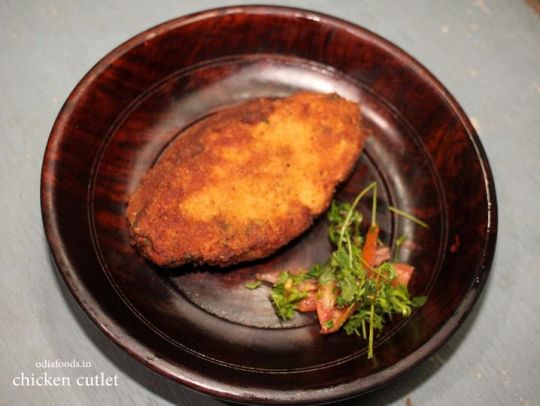
Bengali-style chicken cutlet is a delicious and flavorful dish typically made with minced or shredded chicken, potatoes, and various spices. Here's a basic recipe to make Bengali-style chicken cutlet that i follow.
INGREDIENTS:
500 grams minced chicken
2 medium-sized potatoes, boiled and mashed (optional , i have not used this for my cutlet )
1 large onion, finely chopped
2-3 green chilies, finely chopped (adjust to taste)
1 spoon Red Chiles powder
2-3 cloves garlic, minced
1-inch piece of ginger, minced
1 teaspoon garam masala powder
1 teaspoon coriander powder
1/2 teaspoon cumin powder
1/2 teaspoon turmeric powder
Salt to taste
Fresh coriander leaves, chopped
Fresh Podina leaves, chopped
Fresh Ajawain leaves, chopped
Bread crumbs
3 Eggs
Oil for frying
The egg coating adds a delicious crispy texture to the chicken cutlets and helps the bread crumbs adhere better. Enjoy your tasty chicken cutlets with this extra layer of flavor!
OdiaFoods.in primarily celebrates the rich cuisine of Odisha while also offering a glimpse into national and international culinary delights. Rooted in Odia tradition, it embraces diversity, catering to both local and global palates with authentic flavors and recipes.
2 notes
·
View notes
Text
Roasted Cauliflower and Leek Quiche (Vegetarian)

Leftover Roasted Cauliflower and Garden Leeks make a hearty, fragrant and vibrant Roasted Cauliflower and Leek Quiche, a tasty picnic if you're on your way home from a long weekend! Happy Monday!
Ingredients (serves 4 to 8)
2 large Garden Leeks
1 tablespoon unsalted butter
½ tablespoon olive oil
450 grams/1 pound chilled Pâte Brisée
6 large eggs
¾ cup crème fraîche or sour cream
¼ cup semi-skimmed milk
¼ teaspoon salt
½ teaspoon freshly cracked black pepper
1/4 teaspoon Garam Masala
1/4 teaspoon ground turmeric
3/4 cup to a cup leftover Turmeric and Cumin Roasted Cauliflower
Thoroughly rinse Garden Leeks under cold water, removing any dirt.
Melt butter with olive oil in a nonstick skillet over medium heat. Cut Leeks into thick slices and add them to the skillet. Cover with the lid, and cook, 5 minutes. Flip leek slices on the other side, cover with the lid, reduce heat to medium-low, and cook, a further 5 minutes. Remove from heat, and let cool completely.
Preheat oven to 200°C/395°F.
Roll Pâte Brisée out thinly onto a lightly floured surface. Fit into a buttered 26cm/10.25″ tart pan, letting the pastry overhang on the edges. Prick the base with a fork. Place a sheet of baking paper onto the Pâte Brisée and fill with dried beans or rice. Blind bake the Pâte Brisée crust at 200°C/395°F, 10 minutes. Carefully remove the beans and baking paper, and bake another 5 minutes, at the same temperature. Remove from the oven. Let cool slightly before trimming the edges.
In a medium bowl, whisk eggs together with crème fraîche. Whisk in milk, salt and black pepper. Stir in Garam Masala and turmeric.
Arrange cooled Leeks onto the tart crust. Cut Roasted Cauliflower into chunks, and scatter them liberally on top. Pour egg and cream mixture evenly all over.
Place in the warm oven, and bake, at 200°C/395°F, 25 to 30 minutes, until cooked through and crust is beautifully golden brown.
Serve Roasted Cauliflower and Leek Quiche warm or cold, with dressed lettuce.
#Recipe#Food#Roasted Cauliflower and Leek Quiche#Roasted Cauliflower and Leek Quiche Recipe#Quiche#Quiche recipe#Savoury Pie Tart and Pizza#Savoury Pie and Tart#Pâte Brisée#Shortcrust Pastry#Leeks#Garden Leeks#Butter#Olive Oil#Cauliflower#Roasted Cauliflower#Eggs#Crème Fraîche#Creme Fraiche#Sour Cream#Milk#Black Pepper#Black Peppercorns#Picnic#Picnic recipe#Vegetarian Quiche#Vegetarian and Vegan#Meatless Monday
7 notes
·
View notes
Text
Menu Two

Menu two from Bishop and Carruthers' "The Vegetarian Adventure Cookbook"
Stats
Dinner Party Guests: 4
Injuries: 1 minor
Realisations: 1
Instagram Story Features: 1 (own)
Menu Two
Spicy Walnut and Rice Patties: walnuts, brown rice, eggs, wholemeal flour, turmeric, garam masala, cumin seeds, carrot, onion, tasty cheddar cheese, salt and pepper, ginger.
Cheeky Plum Sauce: -
Kumara (or Potato) Salad: potato, apple, celery, onion, spring onion, parsley, cottage cheese, sour cream, garlic, lemon juice, vinaigrette dressing, salt and pepper.
Crunchy Coleslaw: cabbage, carrot, celery, zucchini, garlic vinaigrette dressing.
This week, tainted by menstruation, all traces of hope were gone like August. Every week is a promise but when the month changes it never feels that way. Distance across space can stretch and contract but distance in time only grows. I read a piece by Mark Fisher early this week, about how people talk about hope when they don’t have anything else, that to be hopeful you are passive. After taking that in I wondered what it was I had a flourishing hope for after completing menu one. I’m very impressionable. I meant for each menu to stand alone, to not think about the previous week after it was done, but when there are dots I will connect them.


Kitchen tidy ready for cooking
The journey toward menu two began on the Monday, the fourth day of September. I was excited by the Cheeky Plum Sauce, the way I am excited by all things cheeky. They’re mischievous, they’re riveting, they’re crazy, they’re confusing and they’re illusive. But most of all, they are always unattainable. I realised that after visiting seven different supermarkets in two days looking for the 850 gram tin of Black Doris Plums in Juice. Driven crazy, I was prepared to spend $22.99 on a 580 gram jar of Black Doris in Pinot Noir Syrup. I walked to the organic grocery store close to my house in high wind, crouching in front of the baking essentials shelf, I remembered all my past mistakes and realised I had to stop. The next day, a salesman came to my work to ask why we had stopped using him as a supplier. I thought about how we were similar in the sense that we both had issues giving up.


Baking essentials shelf and defeat
I spent Tuesday assembling salads. Around 10PM my flatmate and usual dinner guest came through to the kitchen and remarked man, this is a full time job. The comment stirred inner thoughts and questions regarding the fact that I already have a full time job. I became stressed and tired. The headlining dish of menu two was the Spicy Walnut and Rice Patties. But because of what happened, and I think I intuited this, this week became about something so much bigger than cooking the menu itself. The rice patties fell apart, no longer patties, they were served as fried rice. The dinner party was a success, two salads, fried rice, and a store bought plum sauce were taken to the table. Everyone cleared their plates, seconds were dished up. But I felt so empty. There were three quarters too much onion in potato salad, Bishop and Carruthers had clearly stated one quarter of an onion, and I accidentally threw in the whole thing.I had always intended to do half, but never whole. This menu became a symbol of reinvention. The rice patties were reinvented as fried rice and on Thursday, I got a haircut hoping that it would change everything about myself.


Served and seconds being taken.
#food#cooking#foodblogger#self discovery#journey#blog#recipes#home cooking#healing#self awareness#foodpics#vegetarian#self aware queen
2 notes
·
View notes
Text
Udaipur’s Culinary Secrets: Beyond Dal Baati Churma

When people think of Rajasthani cuisine, the first dish that comes to mind is often Dal Baati Churma — a delicious combination of baked wheat balls, lentils, and sweet crumbled wheat. While this iconic dish truly represents the flavors of Rajasthan, Udaipur’s food culture goes far deeper. The city’s culinary landscape is a fascinating blend of royal delicacies, street food favorites, and hidden gems that reflect its history and geography.
For food lovers, exploring Udaipur’s cuisine is a journey into traditions that have been passed down through generations.
The Royal Influence on Udaipur’s Cuisine
As the seat of the Mewar dynasty, Udaipur’s kitchens were influenced by royal tastes. The Maharajas and Maharanis loved lavish feasts, and their chefs created dishes rich in flavor and presentation.
Laal Maas: A fiery mutton curry made with red chilies and spices, often cooked slowly for hours to enhance its taste.
Safed Maas: A milder dish with a creamy base of yogurt, cashews, and almonds.
Game Meats: Historically, royal feasts featured game meats like wild boar, quail, and venison, cooked with spices and nuts.
Many of these dishes continue to be served in heritage hotels and fine-dining restaurants across Udaipur.
Udaipur’s Street Food Culture
The bustling lanes of Udaipur are packed with vendors serving quick, flavorful snacks. Street food here is not just about taste but also about community and culture.
Kachoris: Deep-fried pastries filled with lentils or onions, best enjoyed with chutneys.
Mirchi Bada: Large green chilies stuffed and fried, a favorite during monsoon.
Poha: Flattened rice cooked with spices, garnished with sev and coriander — a popular breakfast choice.
Bread Pakoras and Samosas: Served hot with masala tea, perfect for evening cravings.
Street food corners near Ghanta Ghar and Fateh Sagar Lake are among the most loved by both locals and tourists.
Sweet Delights of Udaipur
Rajasthan is known for its sweets, and Udaipur is no exception. Beyond churma, the city offers a wide variety of desserts that can satisfy any sweet tooth.
Ghevar: A disc-shaped sweet soaked in sugar syrup, often enjoyed during Teej and Raksha Bandhan.
Malpua: Pancake-like sweets, often paired with rabri.
Moong Dal Halwa: A rich dessert made from ghee and lentils, served warm in winters.
Rabdi: Thickened milk flavored with saffron and nuts, a must-try at local sweet shops.
Vegetarian Paradise
Udaipur is also a haven for vegetarians. With Jain and Vaishnav influences, many restaurants serve dishes without onion and garlic. Some must-try vegetarian delicacies include:
Gatte ki Sabzi: Gram flour dumplings in spicy curry.
Ker Sangri: A desert bean and berry dish, unique to Rajasthan.
Sev Tamatar ki Sabzi: A tangy tomato-based curry topped with crunchy sev.
These humble yet flavorful dishes capture the essence of Rajasthan’s vegetarian culture.
Fusion and Modern Cafés
Alongside its traditional fare, Udaipur has embraced contemporary dining trends. Rooftop cafés overlooking Lake Pichola or Fateh Sagar serve wood-fired pizzas, pastas, and global fusion dishes. These cafés attract younger travelers and offer a balance between traditional Rajasthani flavors and international tastes.
Food Festivals and Local Markets
Exploring Hathi Pol Bazaar and Chetak Circle not only introduces travelers to spices, pickles, and snacks but also reflects the city’s vibrant food culture. Food festivals in Udaipur, often organized in winter, bring together traditional and modern cuisines for a grand celebration.
Culinary Experiences for Tourists
Cooking Classes: Many local families invite tourists to learn the secrets of Rajasthani cooking.
Food Walks: Guided tours through old markets that combine history with bites of local delicacies.
Dining at Heritage Hotels: Offers a royal dining experience with authentic Mewari recipes.
Conclusion
While Dal Baati Churma remains the star of Rajasthani cuisine, Udaipur’s culinary scene is a much richer tapestry. From fiery meat curries and vegetarian specialties to sweet delights and innovative street food, the city is a paradise for food enthusiasts.
For those eager to savor Udaipur’s flavors — from hidden street stalls to royal dining halls — a One Way Taxi Service in Udaipur ensures you can comfortably explore every corner of the city’s food map.
In Udaipur, every dish tells a story, and every bite brings you closer to the city’s cultural heart.
0 notes